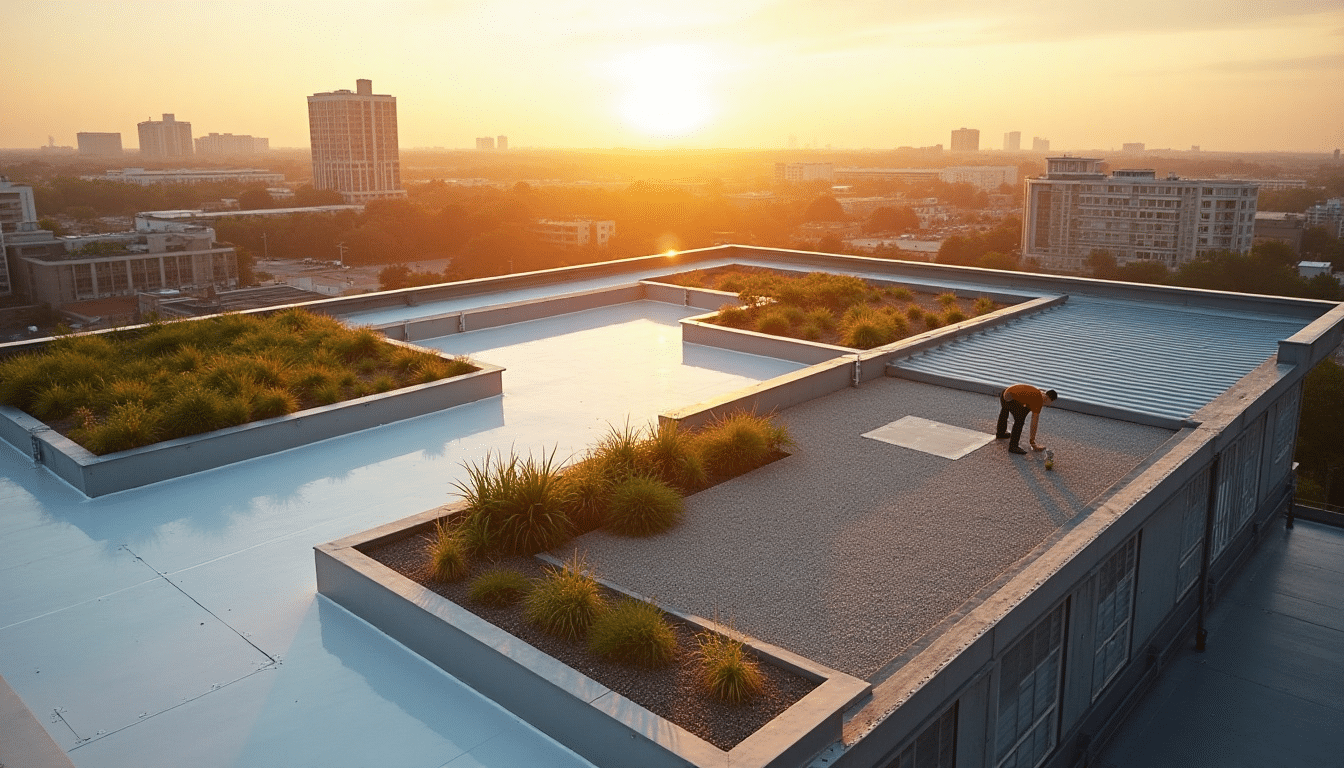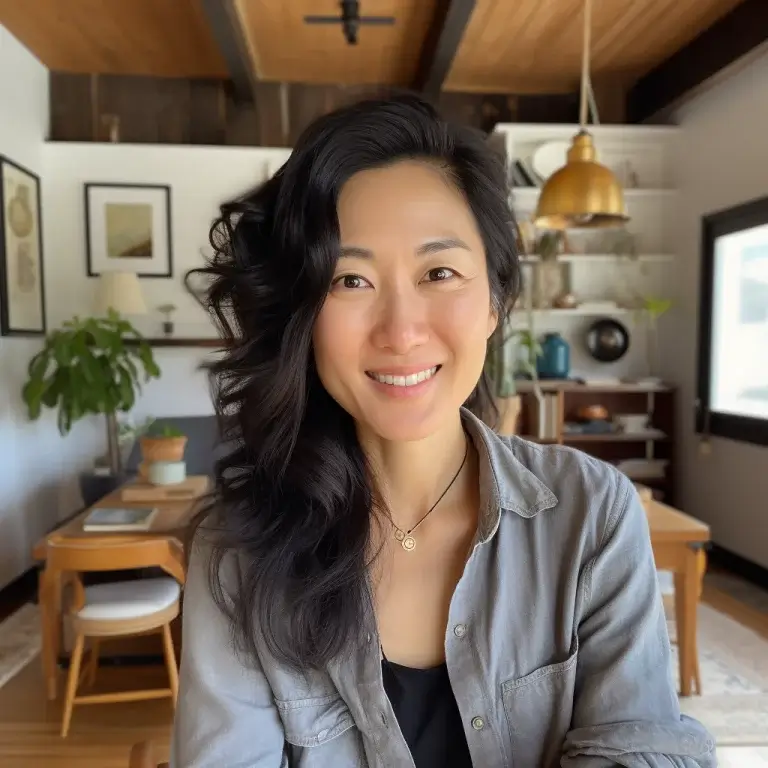Your building needs a new roof, but which flat roofing system fits your needs?
With options ranging from $3 to $25 per square foot, making the right choice matters. Today’s flat roofing technology offers solutions for every budget and climate.
Nine distinct systems serve different purposes. From traditional tar-and-gravel to modern green roofs, each has specific advantages. Smart property owners evaluate materials based on climate, structure, and maintenance needs before investing.
This guide examines every major flat roofing system available. You’ll learn the costs and benefits. Make an informed decision that protects your investment for decades.
What Is a Flat Roof?
A flat roof is a nearly level roofing system with a slight slope. Unlike sloped roofs, these surfaces appear horizontal. The minimal pitch allows water drainage while maximizing usable space.
Flat roofs typically have a slope between 1/4 inch and 2 inches per foot. This design is common in commercial buildings and modern homes.
The low profile makes maintenance easier. Many property owners choose flat roofs for their cost-effectiveness and contemporary appearance.
Key Types of Flat Roof Systems
Modern flat roofs come in various materials and designs. Each system offers unique benefits for different building needs. Understanding these types of flat roofs helps property owners make informed decisions about their roofing investment.
1. Built-Up Roofing (BUR)
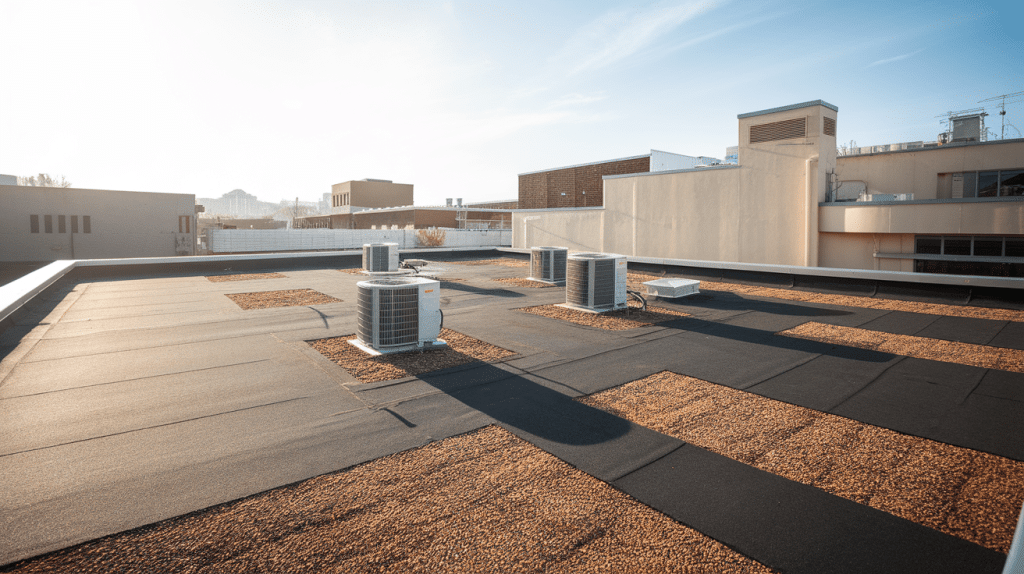
Built-up roofing uses multiple layers of tar and gravel. This traditional system alternates between bitumen and reinforcing fabric. Roofers apply three to five layers for strength.
The top layer features gravel or mineral surfacing. BUR roofs last 15 to 30 years with proper care. They resist fire and provide good insulation.
However, these roofs are heavy and need strong support. Finding leaks can be difficult. Installation creates a mess and odors. Regular maintenance keeps BUR roofs functional.
2. Modified Bitumen Roofing (MBR)
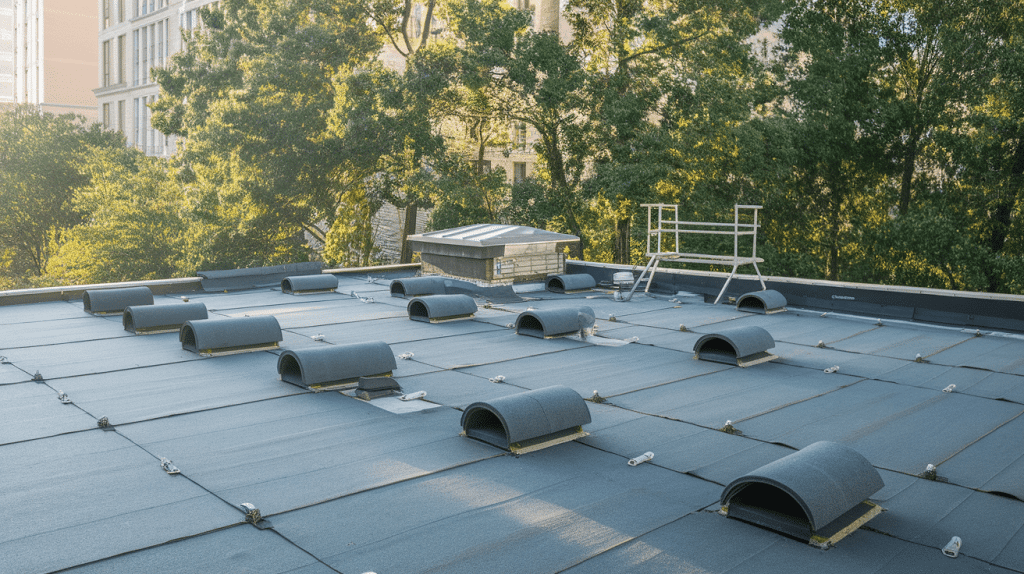
Modified bitumen combines asphalt with polymer modifiers. These sheets come in rolls for easier installation. Roofers use torch-down or peel-and-stick methods.
The material stays flexible in various temperatures. UV-resistant surfaces protect against sun damage. MBR works well for residential buildings.
The moderate weight suits most structures. These roofs typically last 10 to 20 years. Seams may develop leaks over time. Foot traffic can damage the surface. Professional installation ensures proper sealing.
3. Single-Ply Membrane Roofing
EPDM (Rubber)
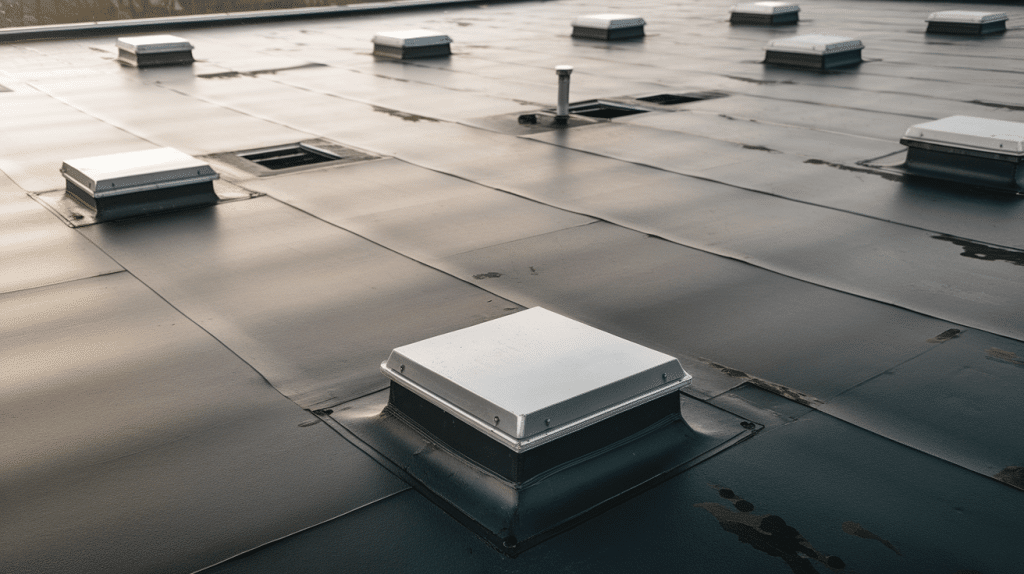
EPDM uses synthetic rubber sheets for coverage. Installation involves adhesive, fasteners, or ballast stones. When comparing types of flat roofs, EPDM offers the best budget value. Repairs are simple and quick.
Black EPDM absorbs heat in summer. White options reflect sunlight better. These membranes last 20 to 30 years. Seams remain the weakest points. Regular inspections prevent major issues.
TPO & PVC
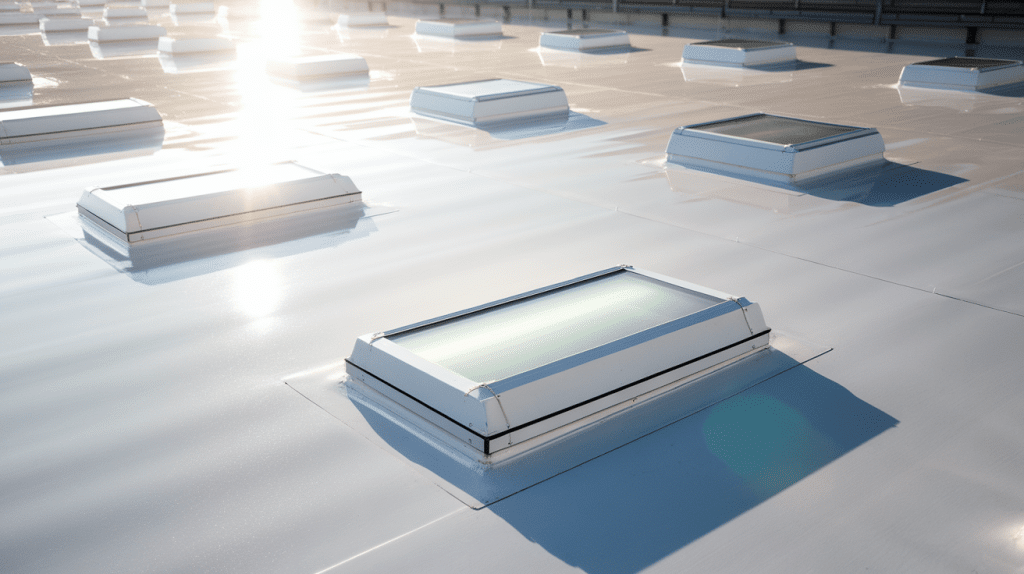
TPO offers thermoplastic protection for flat surfaces. This white material reflects heat effectively. Energy bills decrease with TPO installation. The material resists chemicals and tears. TPO roofs last 10 to 20 years.
PVC provides similar benefits with added strength. Both materials need professional seam welding. Costs vary based on thickness. Quality installation prevents early failures.
4. Spray Foam Roofing (SPF)
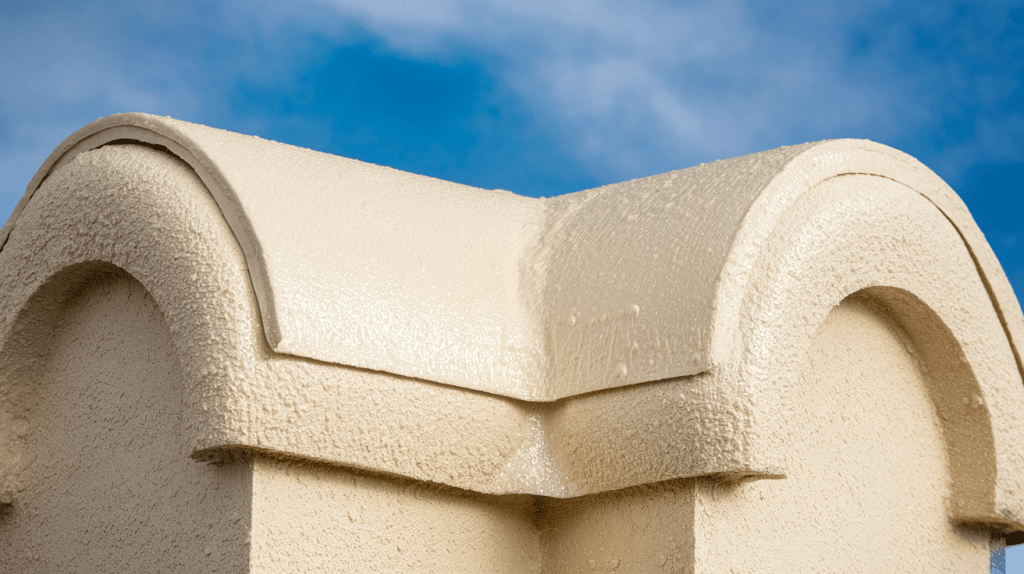
Spray foam creates seamless roof coverage. Polyurethane foam expands upon application. A protective coating shields the foam.
This system provides excellent insulation value. Irregular roof shapes benefit from foam. The seamless surface prevents water intrusion.
UV rays damage uncoated foam quickly. Annual inspections maintain the protective layer. Professional contractors ensure proper thickness. Foam roofing adapts to unique designs.
5. Green Roofs (Vegetated Roofs)
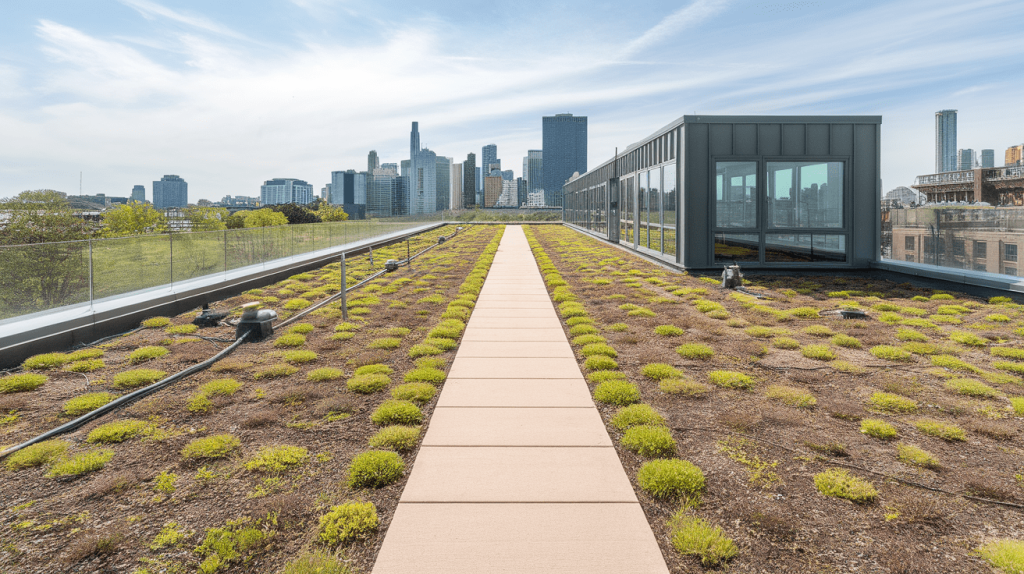
Green roofs support living plants above waterproofing. Extensive systems use shallow soil and sedums. Intensive designs create rooftop gardens. Plants provide natural insulation year-round.
Stormwater management improves with vegetation. Wildlife habitats form in urban areas. Initial costs exceed traditional roofing. Structural support must handle extra weight.
Regular gardening maintains plant health. Drainage systems prevent water damage.
6. Protected Membrane Roof (PMR)
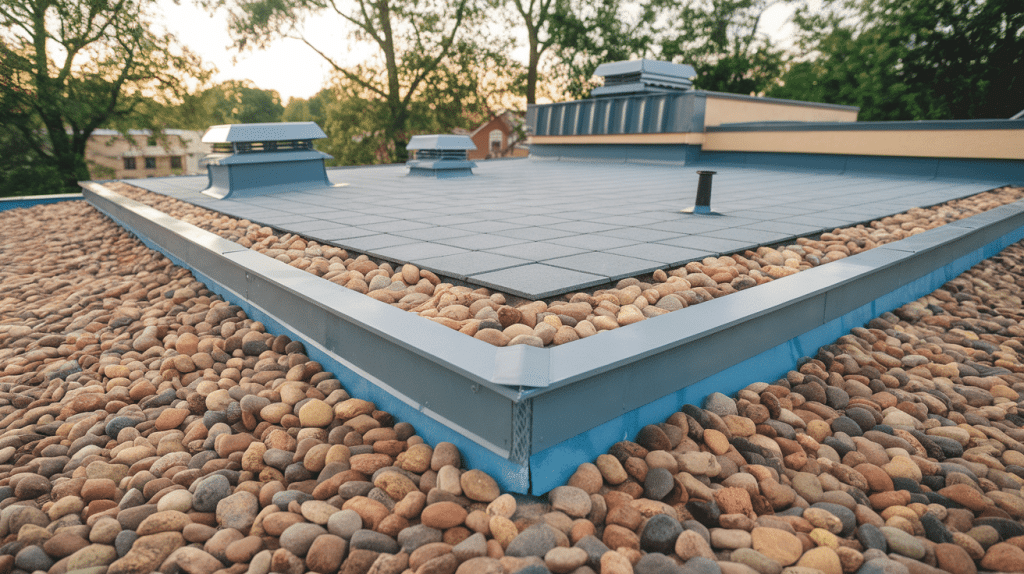
PMR systems place insulation above the membrane. This inverted design protects waterproofing layers. Ballast stones or pavers hold insulation down. Temperature changes affect the membrane less.
The protected position extends membrane life. Thermal stability improves building comfort. Extra weight requires structural analysis. Installation costs more than standard systems.
Maintenance access remains straightforward. This design suits extreme climates.
7. Blue Roof
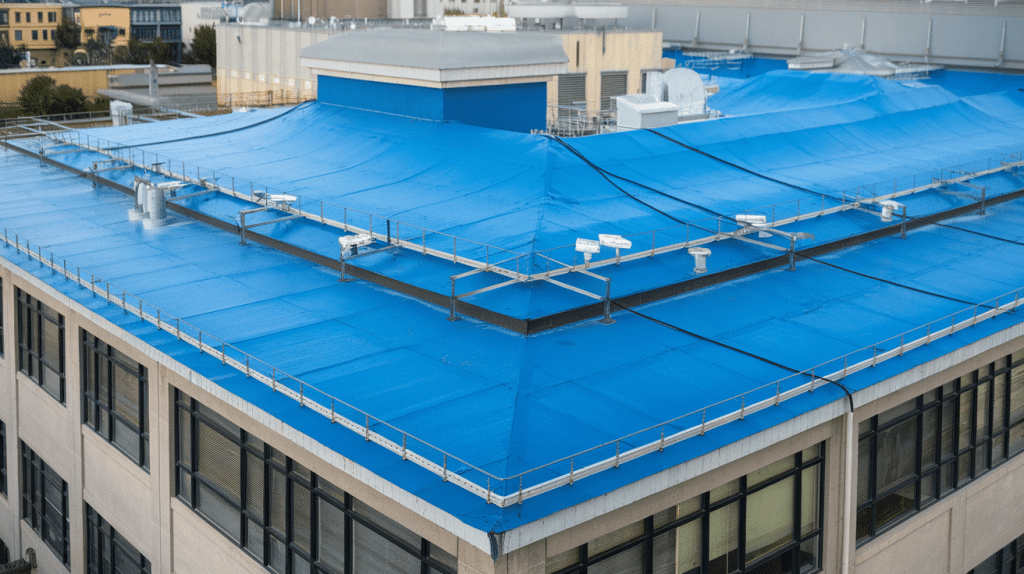
Blue roofs store rainwater temporarily. Controlled drainage prevents urban flooding. Special outlets regulate water release rates. Cities use these for stormwater management.
The stored water may serve irrigation needs. Design requires engineering expertise. Residential applications remain rare. Commercial buildings benefit most. Regular inspections ensure proper function. Blue roofs support sustainable urban planning.
Comparison Table: Types of Flat Roofs
| Material | Cost/Sq Ft | Lifespan | Pros | Cons |
|---|---|---|---|---|
| BUR | $4 – $10 | 15–30 years | Fire-resistant, excellent insulation, proven durability | Heavy weight, difficult leak detection, messy installation |
| Modified Bitumen | $3 – $6 | 10–20 years | Flexible in temperature, UV-resistant, and moderate cost | Shorter lifespan, severe vulnerability, limited foot traffic tolerance |
| EPDM | $3.50 – $7.50 | 20–30 years | Lightweight, inexpensive, and easy repairs | Heat absorption (black), aesthetic limitations, seam weakness |
| TPO | $5 – $8.50 | 10–20 years | Energy-efficient, reflective, chemical-resistant | Seam integrity concerns, skilled installation required |
| PVC | $6 – $9 | 15–25 years | Strong chemical resistance, tear-resistant, durable seams | Higher cost, plasticizer migration issues |
| Spray Foam | $4.50 – $7 | 20+ years | Seamless coverage, superior insulation, adapts to complex shapes | UV sensitivity, skilled install needed, periodic recoating |
| Green Roof | $15 – $25 | 40+ years | Environmental benefits, insulation, and stormwater management | High initial cost, structural reinforcement needed, |
| PMR | $8 – $12 | 25–35 years | Extended membrane life, thermal stability, waterproofing protection | Heavy, costly to install, and requires structural analysis |
| Blue Roof | $10 – $15 | 20-30 years | Flood mitigation, water reuse | Specialized design, limited use |
Factors for Picking a Flat Roof Type
Selecting the right flat roof material requires careful evaluation of multiple factors. Each building has unique needs that affect material choice. Consider these key aspects before making your final decision.
Budget: Material costs range from $3 to $25 per square foot. Installation complexity and local labor rates affect total expenses. Balance initial investment with long-term energy savings.
Climate: Your local weather determines material performance requirements. Hot regions need reflective surfaces while cold areas require superior insulation. Choose materials that withstand your specific weather patterns.
Weight & Structure: Check your building’s load capacity before selecting heavy options. Green roofs and ballasted systems add significant weight. Older structures may need reinforcement for heavier materials.
Usable Roof Space: Consider how you’ll use the rooftop area. High-traffic areas need durable walking surfaces. Equipment placement and future modifications affect material selection.
Longevity & Warranty: Compare warranty periods and coverage details carefully. Quality materials offer warranties of 20-30 years. Proper maintenance validates warranty claims and extends roof life.
Aesthetic Goals: Visible roofs impact your property’s overall appearance. Color and texture options vary by material. Match roofing choices with architectural style and neighborhood standards.
Conclusion
Choosing among different types of flat roofs requires careful consideration of your specific needs. Budget, climate, and building structure all play crucial roles in this decision. Each material offers distinct advantages for various applications.
Modern flat roofing systems provide reliable protection when properly installed and maintained. From traditional BUR to innovative green roofs, options exist for every project.
Regular maintenance protects your investment regardless of which system you choose. Simple steps like clearing drains and scheduling inspections prevent costly repairs. The right flat roof adds value while protecting your property for decades.
Ready to install a new flat roof? Contact a certified roofing contractor today for a professional assessment and personalized recommendations for your building.
Frequently Asked Questions
What Are the Three Main Types of Roofs?
The three main roof categories are flat roofs, pitched roofs, and curved roofs. Flat roofs have minimal slope. Pitched roofs angle sharply. Curved designs include domes and arches.
What is a 3 3-layer Flat Roof System?
A 3-layer system includes decking, insulation, and a waterproof membrane. The deck provides structural support. Insulation controls temperature. The top membrane keeps water out and protects the underlying layers.
What Is Best for Flat Roofs?
TPO and PVC offer excellent value for most flat roofs. Both resist the weather and reflect heat. Commercial buildings prefer TPO. Residential properties benefit from either option’s reliable performance.
Which is Best, EPDM or GRP?
EPDM suits budget-conscious projects with simple designs. GRP (fiberglass) provides seamless coverage and longer life. Choose EPDM for cost savings. Select GRP for durability and minimal maintenance.

